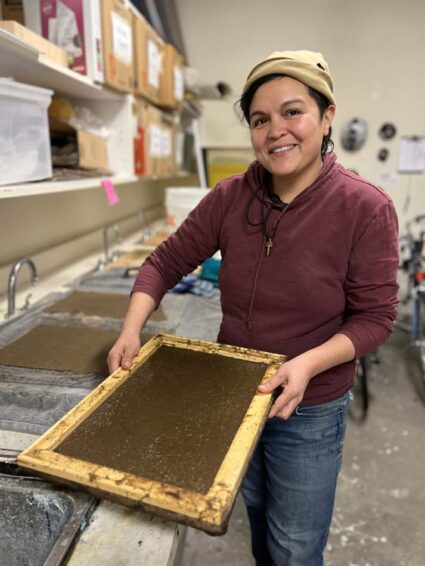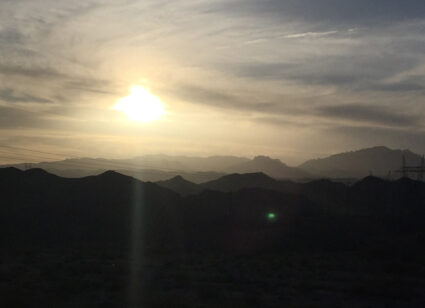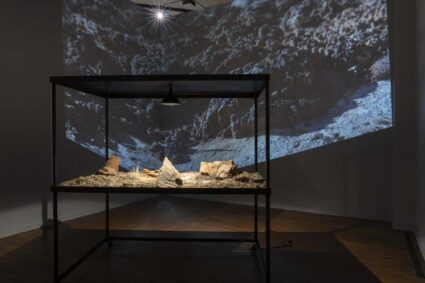Artist Derrick Velasquez, who is represented by Robischon Gallery and runs Yes Ma’am and Friend of a Friend, is a pillar in Denver’s gallery and DIY scenes.
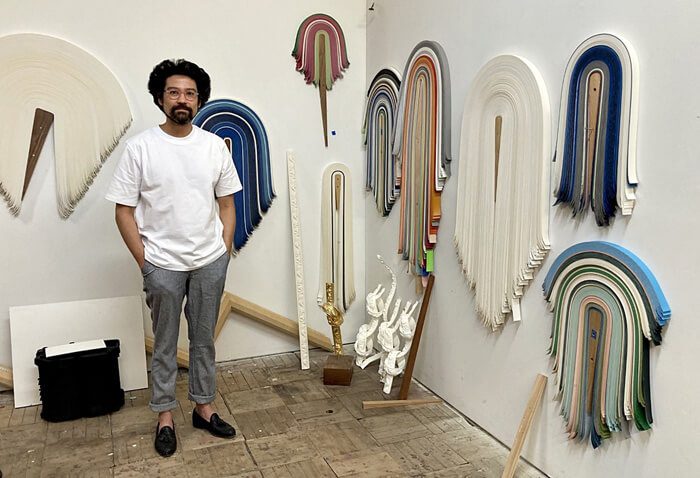
In a lower-level room at Tank Studios, Denver-based Derrick Velasquez, who’s represented by Robischon Gallery, sits next to a table covered with a green cutting mat and an in-process collage. Vinyl artworks in various stages of completion adorn the studio walls.
Situated in a far corner of the space, trim molding twisted into non-architectural shapes rests on the floor. A few small paintings hang near the open doorway that exits into the main hallway. In the back of the studio, wood shelving holds bolts of fabric—the raw materials for the artist’s signature Untitled series of wall-mounted sculptures.
Velasquez moved to Denver in 2008 after earning his MFA from the Ohio State University (and, previous to that, a BFA from the University of California, Santa Barbara). During the intervening years, he transformed into a central figure in the local art scene and beyond. A recipient of the prestigious Joan Mitchell Foundation Grant for Painters and Sculptors and a MacDowell fellow, his work has shown in galleries across the country as well as at the Museum of Contemporary Art in Denver and the New Mexico Museum of Art.
But more than just developing into a successful artist, Velasquez plays an important role as a supporter of the arts. He runs and curates several local galleries that broaden the profile of emerging artists, and sits on the board for art organizations such as Tilt West, Union Hall, and the Denver Commission for Cultural Affairs. In doing so, his creative and organizational reach extends to nearly every facet of Denver’s art community.
As we chatted in his studio, Velasquez reflected on the creation of Tank Studios.
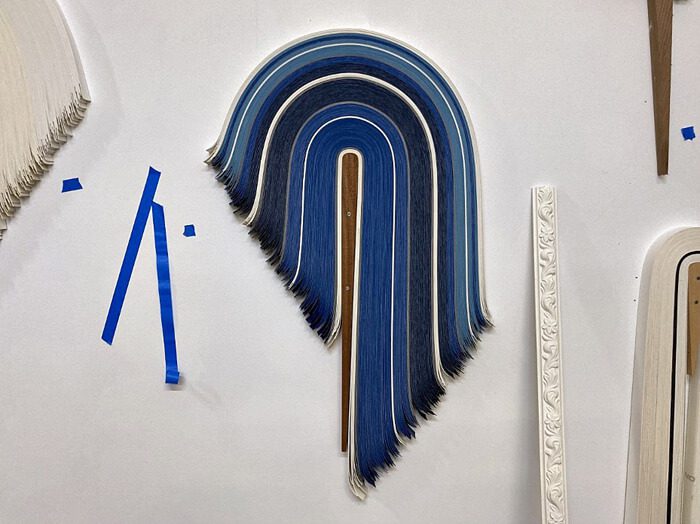
“In 2012, ten artists were exiting [the Denver residency program] RedLine at the same time and were looking for new space,” he says. In order to sustain the sense of camaraderie developed during his years at RedLine, he spearheaded a search for available warehouses that they could transform into studios.
After an extended hunt for viable locations, which proved difficult due to the marijuana sector’s stranglehold on the city’s industrial space, the artists settled on their current 1474 South Acoma Street address, which they share with a cabinet-making company.
“We all know each other. We’re family. And we’re… in business together,” the artist notes of his colleagues who rent space at Tank. “There’s a general [sense of] inspiration from people being around and getting to see their studios that keeps us going,” he says.
As for his own art practice, Velasquez attends to a variety of media and materials. But his Untitled series—which exudes a maturity of vision and formal austerity—occupies his principal focus. The pieces contain a central wooden spine positioned perpendicularly to—or at a slight angle from—the floor (less frequently, he’ll arrange the spines horizontally). Alternating strips of colored vinyl, approximately two inches in width, drape over the spine and splay at the edges.
While the Untitled series might exhibit an affinity with painting, the artist primarily conceptualizes the artworks through their relationship to the human body. “It looks like a shoulder. It has an armature, a bone with ligaments tied to it. Muscle with skin on top of it. People want to have conversations about painting, but I immediately steer it to something else.”
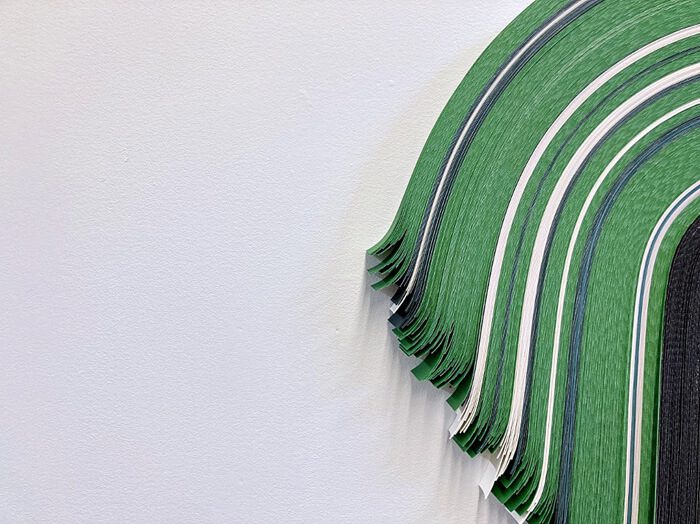
The impetus for his series derived from several sources, one of which was labor-intensive employment Velasquez held previous to his professional art career.
“One of the biggest influences on my [practice],” he says, “was working in a cannery during summers while I was an undergrad. We canned peaches, apricots, and tomatoes.” The abundance of produce entering the canning facility impressed him, but it was the stacks of “a million cans a day” in a single space that proved revelatory. Velasquez notes, “Accumulation has always been interesting to me,” which can be seen in the layering of dozens (if not hundreds) vinyl strips in his Untitled pieces.
“The material itself,” as Velasquez explains, “comes from book-binding. I was craft book-binding when I moved to Denver and [participating in] fairs across the country. Looking for leather alternatives, I found vinyl Naugahyde, which is used in cars and boats.”
Once he began making more of these objects and showing them to an audience, Velasquez realized that “because they were abstract, people would start making their own interpretations” about their meaning; this prompted the artist to consider his “physical and conceptual relationship… to them.” It was at this juncture that he more thoroughly developed the connections between his work and the human form. “It’s a making process that uses every aspect of my body,” he says. “Almost all artwork is related to the body, but I’m a laborer when I make these. And that’s when I thought of them as my own body.”
Velasquez, though, is more than an accomplished artist. In March 2017, he opened the DIY space Yes Ma’am Projects in the basement of his west Denver home. The project showcases up-and-coming artists at both the local and national levels.
Recently, he opened Friend of a Friend in downtown Denver’s historic Evans School Building. The gallery, billed as a “temporary and itinerant project space,” focuses on younger artists in the local community, providing exposure for the creative output of those who have not yet attained an expansive reach.
With both of these projects, Velasquez channels his own success as an artist back into the community in order to uplift and maintain the city’s cultural and creative landscape.
As someone who plans to remain in Denver long-term—even as other artists leave due to untenable financial restrictions—Velasquez understands his involvement as a gallerist is fundamental to preserving what’s left of Denver’s creative and artistic community.
“It’s something that I have to do or else this city will fucking die,” Velasquez says. “There’s definitely good DIY and artist-run spaces springing up, but as Denver gets more expensive, that could easily disappear.”
This generosity of spirit and his willingness to promote other artists serves as a refreshing alternative to more ego-driven personalities often encountered in the art world. “It’s something that I feel I have to do because I have the energy and the resources.” And for that, the creative community of Denver is grateful.
Indeed, his efforts help maintain a vibrant cultural landscape in a city whose planning and infrastructure make living and working as an artist more difficult by the day.
